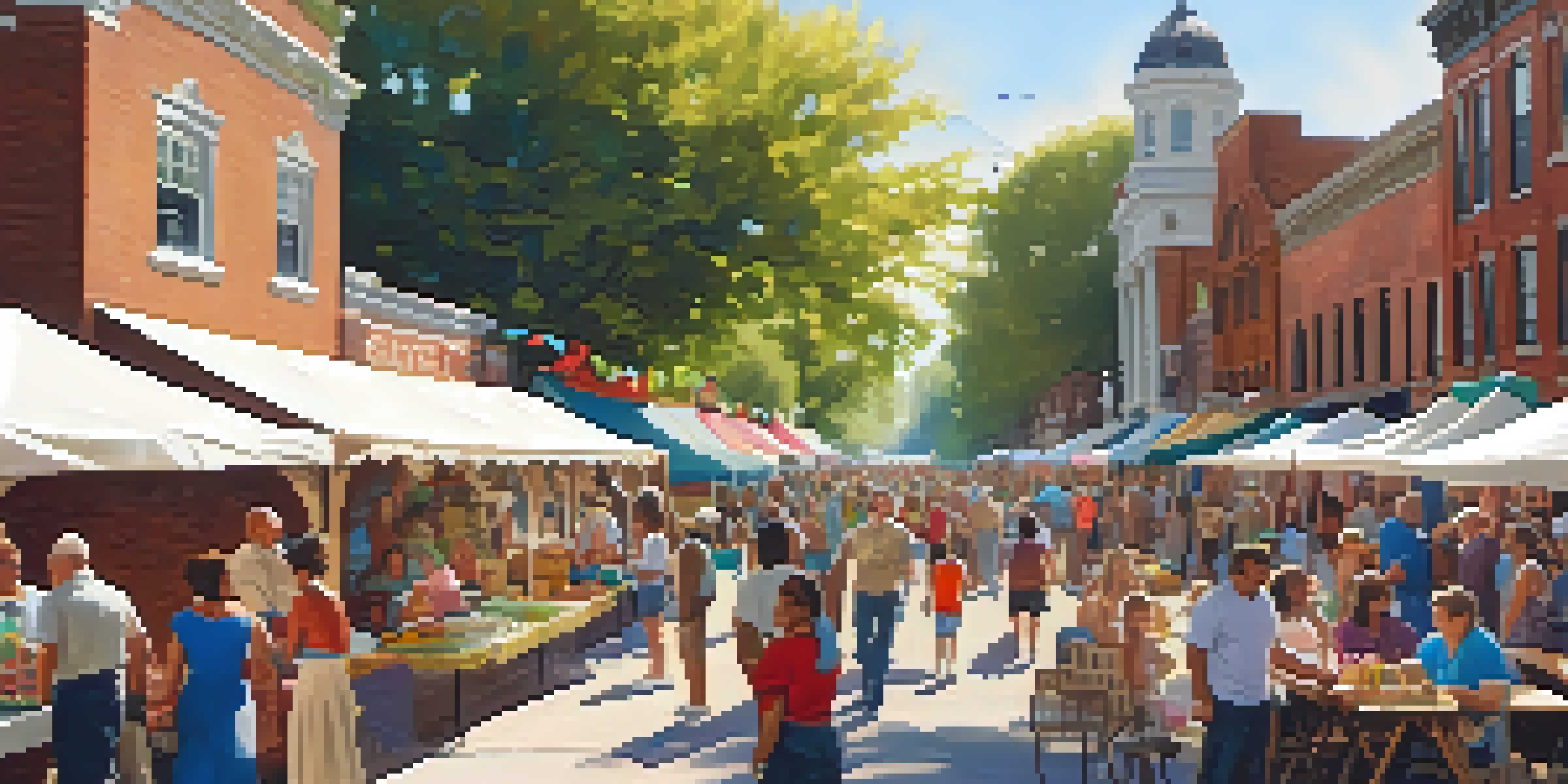Community Involvement in Arizona's Historic Preservation

The Importance of Community Involvement in Preservation
Community involvement is crucial in preservation efforts, as local residents often hold the key to understanding the historical significance of their neighborhoods. When people actively participate in preserving their heritage, they foster a sense of pride and identity that enriches the community. This engagement not only helps protect historic sites but also encourages a collective responsibility for local history.
Preservation is a way of keeping our past alive for future generations to enjoy and learn from.
In Arizona, where diverse cultures and histories converge, community voices play an essential role in deciding what should be preserved. By collaborating with local historians, architects, and preservationists, residents can help ensure that vital narratives and architectural styles are not lost to time. This grassroots approach often leads to more meaningful outcomes, as the preservation reflects the community’s values and memories.
Moreover, when a community comes together to protect its history, it can create a stronger bond among its members. Events like local history fairs or preservation workshops foster connections and encourage conversations about the past, reinforcing the significance of shared stories and traditions. Ultimately, this unity is vital for sustaining the cultural landscape of Arizona.
Key Organizations Supporting Preservation Efforts
Several organizations in Arizona are dedicated to supporting community-driven preservation initiatives. Groups like the Arizona Preservation Foundation and the National Trust for Historic Preservation work tirelessly to provide resources, education, and funding opportunities for local projects. By partnering with these organizations, communities can access valuable tools to amplify their preservation efforts.

In addition to funding, these organizations often offer workshops and training sessions that empower community members with the knowledge needed to carry out preservation activities. For instance, they might teach residents about grant writing, historic tax credits, or how to navigate the preservation process. This capacity-building is essential for fostering sustainable preservation practices in Arizona.
Community Drives Preservation Success
Active community involvement is essential for preserving local history and fostering a sense of identity among residents.
Moreover, these organizations often act as advocates for communities, helping them navigate the complexities of local and state regulations. By elevating community voices within the political landscape, they ensure that preservation efforts align with the interests and needs of the community. This collaborative spirit is vital for cultivating a culture of preservation across Arizona.
Success Stories of Local Preservation Projects
Across Arizona, numerous success stories highlight the impact of community involvement in historic preservation. For example, the restoration of the historic downtown district in Flagstaff showcases how residents banded together to revitalize their area while preserving its unique character. This project not only enhanced the aesthetic appeal of downtown but also attracted new businesses and tourism.
Communities that come together to celebrate their history not only protect their heritage but also strengthen their bonds.
Another inspiring example is the preservation of the historic homes in Tucson’s Barrio Viejo neighborhood. Community members fought to protect these homes from demolition, emphasizing their cultural significance and architectural beauty. By organizing neighborhood meetings and rallies, they successfully raised awareness and garnered support for preservation efforts.
These successes demonstrate the power of collective action and the positive outcomes that can arise when communities prioritize their heritage. Each restored building or revitalized neighborhood tells a story of resilience and commitment, reinforcing the notion that historic preservation is not just about buildings—it's about people and their shared history.
Challenges Faced in Preservation Efforts
While community involvement is vital, preservation efforts often encounter significant challenges. One of the most pressing issues is the limited funding available for restoration projects, which can hinder even the most passionate grassroots initiatives. Without financial support, many communities struggle to maintain or restore their historic sites, leading to deterioration over time.
Additionally, navigating the complexities of local zoning laws and preservation regulations can be daunting for community members. Often, individuals may feel overwhelmed by the bureaucratic processes involved in securing permits or funding, which can stifle their enthusiasm for preservation. Education and support from organizations can mitigate this, but overcoming these hurdles requires persistent effort and collaboration.
Local Organizations Empower Initiatives
Support from organizations like the Arizona Preservation Foundation provides resources and education that enhance community preservation efforts.
Lastly, there is the challenge of balancing modernization with preservation. As communities grow and evolve, the pressure to develop new infrastructure can conflict with the desire to maintain historical integrity. Finding ways to integrate the old with the new while honoring the past is an ongoing challenge that requires thoughtful dialogue and compromise.
The Role of Local Government in Preservation
Local government plays a pivotal role in supporting community involvement in historic preservation. By establishing preservation ordinances and creating heritage commissions, municipalities can provide frameworks that empower residents to actively participate in protecting their history. These policies can set the tone for how communities perceive and engage with their historic resources.
Moreover, local governments can offer financial incentives, such as grants or tax credits, to encourage preservation projects. When communities see that their government supports these initiatives, it can inspire further engagement and collaboration. This support can be instrumental in mobilizing community members toward preservation efforts, ensuring that they feel backed in their endeavors.
Additionally, local governments can facilitate partnerships between community members and preservation organizations, acting as a bridge to connect resources and expertise. By promoting these collaborations, local officials can help ensure that preservation efforts are inclusive and representative of the community’s diverse voices.
Engaging Youth in Preservation Efforts
Involving youth in historic preservation is crucial for ensuring the future of community engagement. Arizona is home to various programs aimed at educating young people about their local history and encouraging them to take an active role in preservation efforts. By instilling a sense of pride and ownership in the next generation, communities can cultivate lifelong advocates for their heritage.
Programs like the Arizona Youth Conservation Corps involve teens in hands-on preservation projects, allowing them to learn practical skills while connecting with their history. These experiences not only educate young people about the importance of preserving their culture but also foster a sense of responsibility towards their community's heritage.
Future Engagement is Vital for Heritage
Engaging youth in preservation initiatives ensures the continuation of local history advocacy and introduces innovative ideas for future projects.
Furthermore, engaging youth can bring fresh perspectives and innovative ideas to preservation efforts. Young people often have a unique understanding of how to utilize technology and social media, which can be leveraged to raise awareness and mobilize support for preservation initiatives. By welcoming youth into the conversation, communities can ensure that their preservation efforts remain relevant and forward-thinking.
The Future of Community Involvement in Preservation
Looking ahead, the future of community involvement in preservation in Arizona appears promising. As awareness of the importance of preserving history grows, more residents are stepping up to advocate for their neighborhoods. This increasing interest hints at a brighter future for historic preservation, where communities actively shape their narratives.
Emerging technologies also present new opportunities for community engagement. Digital platforms enable residents to share their stories, document their heritage, and connect with others who share similar interests. By harnessing these tools, communities can create a vibrant online presence that highlights their preservation efforts and attracts broader support.

Ultimately, the success of historic preservation in Arizona will hinge on the continued collaboration between community members, local governments, and preservation organizations. By fostering an inclusive and participatory environment, Arizona can ensure that its rich history is preserved for generations to come, celebrating the diverse cultures and stories that contribute to its unique identity.